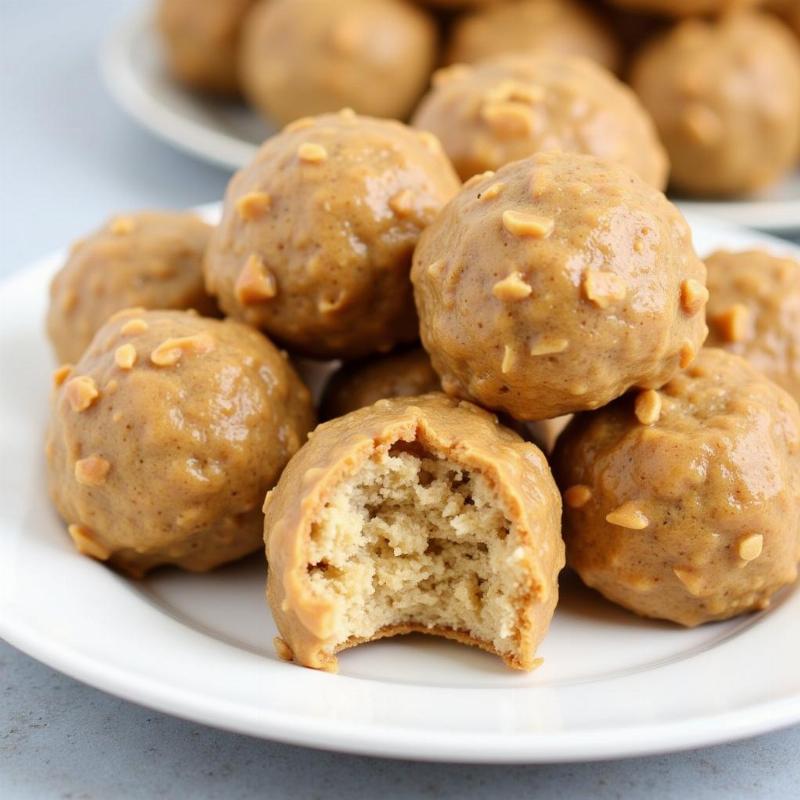Peanut butter balls are a popular and easy-to-make treat for dogs. They’re packed with protein and healthy fats, and most dogs go absolutely crazy for that peanut butter flavor. But before you grab a jar and start rolling, it’s important to know how to make peanut butter balls safely and healthily for your furry friend. This guide will walk you through everything you need to know, from ingredient selection to storage, ensuring your dog enjoys a tasty and nutritious treat.
Choosing the Right Peanut Butter: Xylitol-Free is Key
Not all peanut butters are created equal, especially when it comes to canine consumption. The biggest concern is xylitol, an artificial sweetener found in some brands. Xylitol is extremely toxic to dogs, even in small amounts. It can cause liver failure and even death. Always double-check your peanut butter label to ensure it’s completely xylitol-free. Look for natural peanut butters with minimal added ingredients.
Simple Peanut Butter Ball Recipes for Your Pup
Here are a few simple and delicious peanut butter ball recipes you can try at home:
Classic Peanut Butter and Oats Balls
- 1 cup rolled oats (not instant)
- 1/2 cup xylitol-free peanut butter
- 1/4 cup honey (optional, for added sweetness)
- 2-3 tablespoons water (add more if needed to achieve desired consistency)
Combine all ingredients in a bowl and mix well. Roll into bite-sized balls. Refrigerate for at least 30 minutes before serving.
Banana and Peanut Butter Power Balls
- 1 ripe banana, mashed
- 1/2 cup xylitol-free peanut butter
- 1 cup whole wheat flour
Combine ingredients and mix thoroughly. Roll into small balls. Refrigerate for at least an hour before serving. These are a great source of potassium and fiber!
 Dog-Friendly Peanut Butter and Oat Balls
Dog-Friendly Peanut Butter and Oat Balls
How Many Peanut Butter Balls Can a Dog Eat?
Moderation is key with any treat, even healthy ones like peanut butter balls. These should be given as an occasional treat and not as a meal replacement. Too many can lead to weight gain and other health issues. A good rule of thumb is to limit treats to no more than 10% of your dog’s daily caloric intake. Start with just one or two peanut butter balls and monitor your dog for any adverse reactions.
Creative Ways to Use Peanut Butter Balls
Peanut butter balls aren’t just a tasty snack; they can also be used for training, enriching activities, or administering medication. Try stuffing them into a Kong toy for a mentally stimulating challenge. You can also use them as a high-value reward during training sessions. If your dog needs to take medication, hiding the pill inside a peanut butter ball can make it much easier.
Storing Your Homemade Peanut Butter Balls
Store your peanut butter balls in an airtight container in the refrigerator. They should last for about a week. For longer storage, you can freeze them for up to three months. Thaw completely before serving.
Conclusion: A Delicious and Nutritious Treat in Moderation
Peanut butter balls can be a fantastic treat for your canine companion. Just remember to choose xylitol-free peanut butter, practice moderation, and get creative with how you use them. With a little care, you can provide your dog with a healthy, delicious, and enriching treat they’ll love.
FAQ
-
Can puppies eat peanut butter balls? Yes, puppies can enjoy peanut butter balls, but offer them in very small quantities and ensure the peanut butter is xylitol-free.
-
My dog is allergic to peanuts, are there alternatives? Yes, you can substitute sunflower seed butter or another nut-free butter for peanut butter. Always consult with your veterinarian if you have concerns about food allergies.
-
Can I add other ingredients to peanut butter balls? Yes, you can add ingredients like chopped carrots, apples, or blueberries for added nutrition. Just be sure to avoid toxic ingredients like grapes and raisins.
-
How can I make peanut butter balls without honey? Honey is optional and can be omitted from the recipe. The peanut butter and oats will still bind together.
-
My dog has diabetes, can they eat peanut butter balls? Consult your veterinarian before giving peanut butter balls to a diabetic dog due to the sugar content.
-
What should I do if my dog eats peanut butter with xylitol? Contact your veterinarian or emergency animal hospital immediately. Xylitol poisoning is a serious medical emergency.
Related Articles
- 3 ingredient peanut butter dog treats no bake
- pill pockets for dogs homemade
- how to cook oatmeal for dogs
- indoor activities for dogs on hot days
Beautdogs.us is your premier online resource for all things dog-related in the USA. We provide expert advice on dog breeds, grooming, training, nutrition, and overall wellness. Whether you’re a seasoned dog owner or just starting your journey with a furry friend, Beautdogs.us offers comprehensive and reliable information to help you provide the best possible care for your beloved companion. Contact us for personalized advice at [email protected] or call us at +1 501-555-7529. Visit Beautdogs.us today to learn more.